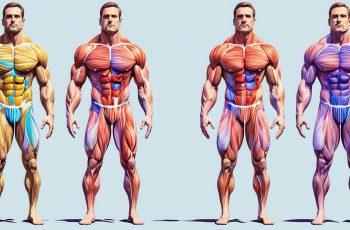Ad Blocker Detected
Our website is made possible by displaying online advertisements to our visitors. Please consider supporting us by disabling your ad blocker.
Testosterone is the male sex hormone that is produced in the testicles. It plays a crucial role in male sexual development and functions, such as the development of male features during puberty and sperm production. However, testosterone levels tend to decrease with age, leading to a condition called Testosterone Deficiency Syndrome (TD) or Low Testosterone (Low-T). The American Urology Association (AUA) defines low blood testosterone as levels below 300 nanograms per deciliter (ng/dL). Symptoms of low testosterone may include low sex drive, fatigue, reduced lean muscle mass, irritability, erectile dysfunction, and depression. It’s important to consult a doctor if you experience these symptoms as they can be caused by various factors, including opioid use, congenital conditions, testicular damage or removal, diabetes, and obesity. Testosterone therapy (TT) may be recommended to treat low testosterone, but it should be carefully considered due to potential risks and side effects.
Key Takeaways:
- Low testosterone, also known as Testosterone Deficiency Syndrome or Low-T, is a condition where testosterone levels decrease, leading to various symptoms.
- Common symptoms of low testosterone in men include low sex drive, fatigue, reduced lean muscle mass, irritability, erectile dysfunction, and depression.
- Consulting a doctor is essential if you experience these symptoms, as they can be caused by multiple factors, including underlying health conditions and lifestyle choices.
- Testosterone therapy may be recommended to treat low testosterone, but it should be carefully evaluated due to potential risks and side effects.
- Effective management of low testosterone can improve overall well-being and quality of life.
Causes and Risk Factors of Low Testosterone
There are several causes and risk factors that can contribute to low testosterone levels in men. Some individuals may be born with conditions that cause testosterone deficiency, such as Klinefelter syndrome, Noonan syndrome, or ambiguous genitalia. Other factors that can lead to low testosterone include testicular damage or removal, chemotherapy or radiation therapy, pituitary gland disease, infection, autoimmune disease, aging, obesity, and the use of certain medications like antidepressants and narcotic pain medications. Men with certain health problems like HIV/AIDS and diabetes are also more likely to have low testosterone. It’s essential to identify and address the underlying cause of low testosterone to effectively treat the condition.
Symptoms of Low Testosterone
Low testosterone can manifest in various symptoms, which can differ from person to person. These symptoms can significantly impact both the overall well-being and quality of life of individuals experiencing them. Specific symptoms of testosterone deficiency may include:
- Reduced sex drive
- Erectile dysfunction
- Loss of body hair
- Decreased beard growth
- Loss of lean muscle mass
- Fatigue
- Obesity
- Symptoms of depression
In addition to these specific symptoms, low testosterone can also contribute to non-specific symptoms such as:
- Lower energy levels
- Poor memory
- Difficulty with finding words
- Poor focus
- Decreased performance at work
If you are experiencing a combination of these symptoms, it is crucial to seek medical attention for further evaluation and diagnosis. Consulting a healthcare professional can help determine the underlying cause of your symptoms and guide you towards appropriate treatment options.

“The symptoms of low testosterone can impact different aspects of a person’s life, from sexual function to energy levels and mental well-being. Recognizing these symptoms and addressing them with medical guidance can lead to improved overall health and quality of life.”
Diagnosis of Low Testosterone
Diagnosing low testosterone involves a comprehensive evaluation that includes a health history assessment and physical examination. During the health history assessment, the doctor will inquire about symptoms, previous medical conditions, injuries or surgeries, medication use, and family history.
A physical examination may involve assessing body mass index (BMI), waist circumference, hair pattern, breast tissue enlargement, testicle size, and prostate health.
Blood tests, including total testosterone level, luteinizing hormone (LH), prolactin level, and hemoglobin, may be conducted to confirm the diagnosis. Additional tests like follicle-stimulating hormone (FSH), estradiol hormone, HbA1C, MRI, bone density tests, and karyotype may be ordered to determine the underlying cause of low testosterone.

“Diagnosing low testosterone involves a comprehensive evaluation that includes a health history assessment and physical examination.”
Treatment Options for Low Testosterone
When it comes to addressing low testosterone, there are various treatment options available. The goal of these treatments is to restore testosterone levels to a normal range and alleviate the associated symptoms. One common approach is testosterone replacement therapy (TRT), which involves administering testosterone through topical gels, injections, patches, or pellets.
The effectiveness of TRT can vary from person to person, so it’s important to note that it should only be considered after a thorough evaluation by a healthcare professional. They will assess your specific needs and guide you through the process. TRT is not a one-size-fits-all solution, and individual factors, preferences, and potential risks and benefits should be considered.
Alongside TRT, there are other treatment approaches that can be pursued to manage low testosterone. Lifestyle modifications such as weight loss, regular exercise, and managing any underlying health conditions can have a positive impact on testosterone levels. These changes can support overall health and potentially improve symptoms related to low testosterone.
“Restoring testosterone levels to a normal range can significantly improve symptoms and enhance the quality of life for individuals with low testosterone.”
It’s crucial to work closely with a healthcare provider to determine the best course of action for managing low testosterone. They will consider your unique circumstances and guide you towards an appropriate treatment plan. Regular monitoring of testosterone levels and symptom evaluation will help track progress and make any necessary adjustments.
Treatment Options for Low Testosterone
| Treatment Option | Description |
|---|---|
| Testosterone Replacement Therapy (TRT) | Administered through topical gels, injections, patches, or pellets to restore testosterone levels. |
| Lifestyle Modifications | Weight loss, regular exercise, and managing underlying health conditions can positively impact testosterone levels. |

Prevalence of Low Testosterone in Men
The prevalence of low testosterone in men can vary depending on age and underlying health conditions. Data suggest that approximately 2.1% of men may have testosterone deficiency, with as low as 1% in younger men and up to 50% in men over 80 years old.
Certain factors, such as being overweight or having diabetes, increase the likelihood of developing low testosterone. For example, a study found that 30% of overweight men had low testosterone compared to 6.4% of those with normal weight. Similarly, 24.5% of men with diabetes had low testosterone compared to 12.6% of those without diabetes.
These numbers may vary due to different cutoff points used for diagnosing testosterone deficiency. It’s crucial to raise awareness about low testosterone and its potential impact on men’s health.

| Age Group | Prevalence of Low Testosterone |
|---|---|
| Youth | 1% |
| Adults | 2.1% |
| Elderly | Up to 50% |
The Impact of Low Testosterone on Sexual Health
Low testosterone can have a significant impact on sexual health and functioning in men. The common symptoms of low testosterone include reduced sex drive, erectile dysfunction, and decreased sperm production. These symptoms can contribute to difficulties with sexual arousal, performance, and overall satisfaction.
Addressing low testosterone and its effects on sexual health is crucial to maintain a fulfilling and healthy sexual relationship. Open communication with a healthcare provider can help explore appropriate treatment options and improve sexual well-being.
Effects of Low Testosterone on Sexual Function
| Effects | Impact on Sexual Function |
|---|---|
| Reduced sex drive | Decreased desire for sexual activity, leading to lower libido |
| Erectile dysfunction | Difficulty achieving or maintaining an erection during sexual activity |
| Decreased sperm production | Reduced fertility and potential difficulties with conception |
These symptoms can significantly affect a person’s ability to engage in sexual activities, leading to frustrations and potential strain on relationships.
By addressing low testosterone and managing its effects on sexual health, individuals can work towards maintaining a fulfilling and satisfying sex life. Seeking help from a healthcare provider is essential in exploring appropriate treatment options and improving overall sexual well-being.
Note: The image above is relevant to the topic of low testosterone and its impact on sexual health.
The Psychological Effects of Low Testosterone
Beyond physical symptoms, low testosterone can also have psychological effects on men. Symptoms of low testosterone, such as fatigue, decreased muscle mass, and obesity, can contribute to feelings of low energy, decreased self-esteem, and reduced motivation. Additionally, hormonal imbalances can affect mood, leading to symptoms of depression and irritability.
Understanding and addressing the psychological effects of low testosterone is crucial for overall well-being and quality of life.
It’s essential to seek support from healthcare professionals to develop a comprehensive treatment plan that addresses both physical and psychological symptoms.
| Psychological Effects of Low Testosterone |
|---|
| Tiredness and fatigue |
| Decreased muscle mass |
| Obesity |
| Low energy |
| Decreased self-esteem |
| Reduced motivation |
| Depression |
| Irritability |
By addressing low testosterone and managing its effects, men can improve their quality of life and overall health.
Managing Low Testosterone and Improving Quality of Life
Managing low testosterone involves a holistic approach aimed at addressing symptoms, improving overall health, and enhancing quality of life. At our clinic, we prioritize personalized treatment plans that take into account the individual needs and goals of each patient.
Hormone replacement therapy (HRT) is often a key component of managing low testosterone. Through HRT, we aim to restore testosterone levels to a normal range, alleviating symptoms such as fatigue, low sex drive, and reduced muscle mass. The specific method of hormone delivery, whether it be injections, gels, patches, or pellets, will be determined based on the patient’s preferences and medical history.
Exercise and Nutrition
Alongside hormone therapy, lifestyle modifications play a crucial role in managing low testosterone. Regular exercise, especially resistance training, can help boost testosterone levels and improve overall well-being. Additionally, adopting a balanced and nutritious diet can support hormone production and optimize health. Our team of healthcare professionals can provide guidance and resources to help patients make sustainable lifestyle changes.
Stress Management and Psychological Support
Stress can negatively impact hormone levels. Therefore, incorporating stress management techniques like meditation, deep breathing exercises, or counseling can be beneficial in managing low testosterone. Our clinic also offers psychological support services to address any emotional or psychological effects of low testosterone, such as depression or anxiety.
Regular Monitoring and Symptom Evaluation
Regular monitoring of testosterone levels is essential to ensure the effectiveness of treatment and maintain optimal hormone balance. We advise patients to schedule follow-up appointments to assess progress, adjust treatment if necessary, and address any concerns or changes in symptoms.
By taking a comprehensive approach to managing low testosterone, individuals can experience improved energy levels, enhanced sexual health, increased muscle mass, and an overall better quality of life. If you’re experiencing symptoms of low testosterone, don’t hesitate to reach out to our clinic for a thorough evaluation and personalized treatment plan.
Potential Risks and Side Effects of Testosterone Therapy
When considering testosterone therapy for low testosterone signs in males or testosterone deficiency symptoms, it’s important to be aware of the potential risks and side effects associated with this treatment. While testosterone therapy can be a beneficial medical intervention, it’s crucial to understand the possible adverse effects that may arise.
Risks and Side Effects
1. Acne: Testosterone therapy can increase oil production in the skin, leading to the development of acne in some individuals.
2. Enlarged Prostate: Testosterone therapy may cause the prostate to enlarge, potentially resulting in urinary symptoms such as increased frequency or difficulty urinating.
3. Shrinking Testicles: Prolonged testosterone therapy can cause the testicles to shrink due to the suppression of natural testosterone production.
4. Decreased Sperm Count: Testosterone therapy can suppress sperm production, leading to a decrease in sperm count and fertility.
5. High Red Blood Cell Count: Testosterone therapy may cause an increase in red blood cell production, which can elevate the risk of blood clots or stroke.
6. Fluid Retention and Swelling: Some individuals may experience fluid retention, leading to swelling in the feet or ankles.
It’s important to note that not all individuals will experience these side effects, and the severity can vary. Discussing potential risks with a healthcare professional is crucial to make an informed decision about testosterone therapy.
“Understanding the potential risks and side effects of testosterone therapy is critical in order to make an informed decision.”
Weighing the Benefits and Risks
While there are potential risks associated with testosterone therapy, for individuals with clinically diagnosed testosterone deficiency and bothersome symptoms, the benefits may outweigh the risks. Testosterone therapy can help improve symptoms such as low sex drive, fatigue, and mood disturbances, enhancing overall well-being and quality of life.
Before considering testosterone therapy, a thorough evaluation by a healthcare professional is essential. This evaluation should include a comprehensive assessment of symptoms, medical history, and an analysis of potential risks and benefits. Ongoing monitoring and follow-up appointments will allow for adjustments in treatment to ensure safety and efficacy.
Conclusion
Low testosterone is a common condition that can have a significant impact on men’s health and well-being. Recognizing the signs and symptoms of low testosterone is essential in seeking appropriate medical evaluation and considering treatment options if necessary.
Testosterone replacement therapy (TRT) can be an effective solution for individuals with clinically diagnosed testosterone deficiency and bothersome symptoms. However, it is important to approach TRT with caution and under the guidance of a healthcare professional. This is due to potential risks and side effects that should be carefully considered.
By addressing low testosterone and managing its effects, men can improve their quality of life and overall health. It is important for individuals to work closely with healthcare professionals to develop personalized treatment plans that address their specific needs and goals.
FAQ
What are the symptoms of low testosterone in men?
Symptoms of low testosterone in men may include low sex drive, fatigue, reduced lean muscle mass, irritability, erectile dysfunction, and depression.
What are the causes and risk factors of low testosterone?
Causes and risk factors of low testosterone include testicular damage or removal, congenital conditions, opioid use, diabetes, obesity, and certain medications.
What are the effects of low testosterone on the body?
Low testosterone can lead to reduced sex drive, erectile dysfunction, loss of body hair, decreased beard growth, fatigue, and obesity.
How is low testosterone diagnosed?
Low testosterone is diagnosed through a comprehensive evaluation that includes a health history assessment, physical examination, and blood tests.
What are the treatment options for low testosterone?
Treatment options for low testosterone may include testosterone replacement therapy, lifestyle modifications, and managing underlying health conditions.
How common is low testosterone in men?
Low testosterone affects approximately 2.1% of men, with prevalence increasing with age and certain health conditions.
How does low testosterone impact sexual health?
Low testosterone can contribute to reduced sex drive, erectile dysfunction, and decreased sperm production, affecting sexual arousal, performance, and satisfaction.
What psychological effects can low testosterone have on men?
Low testosterone can lead to feelings of fatigue, decreased self-esteem, reduced motivation, symptoms of depression, and irritability.
How can low testosterone be managed to improve quality of life?
Managing low testosterone involves hormone replacement therapy, lifestyle modifications, stress management, and psychological support.
What are the potential risks and side effects of testosterone therapy?
Risks and side effects of testosterone therapy may include acne, enlarged prostate, decreased sperm count, high red blood cell count, and swelling.
How Can I Understand and Recognize Low Testosterone Symptoms in Men?
Recognizing symptoms of low testosterone in men is crucial for maintaining overall health. Some common symptoms of low testosterone include decreased libido, fatigue, loss of muscle mass, and mood changes. If these symptoms persist, it is important to consult a healthcare professional for proper diagnosis and treatment.


